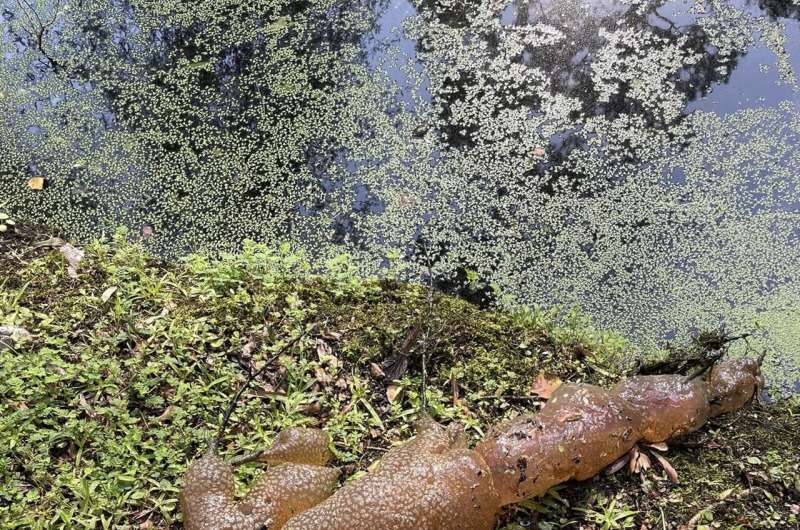This article has been reviewed according to Science X's editorial process and policies. Editors have highlighted the following attributes while ensuring the content's credibility:
fact-checked
trusted source
proofread
Unraveling the mystery of Texas' cryptic freshwater blobs—expert discusses bryozoans

Despite what you may initially think, the gelatinous blobs occasionally found clinging to structures in ponds or reservoirs are not the nefarious, otherworldly creatures seen in classic science fiction or horror films.
Instead, these orbs are likely bryozoans, harmless colonies of minuscule, filter-feeding invertebrates that generally indicate good water quality, said Brittany Chesser, Texas A&M AgriLife Extension Service aquatic vegetation management program specialist and lead diagnostic scientist at AgriLife Extension's Aquatic Diagnostics Laboratory, Bryan-College Station.
"When people look at a bryozoan, they typically think they're looking at one complete organism, but it's really a colony made up of hundreds of individual aquatic invertebrates known as zooids," Chesser said.
A diverse species with prehistoric origins
Chesser said bryozoans can be found in marine, freshwater and brackish environments worldwide. Depending on the species of bryozoan, the colony can take on various forms, from a round, gelatinous mass to a sprawling, moss-like appearance.
According to the U.S. Army Corps of Engineers, of the roughly 4,000 different varieties of bryozoans, only 50 live in freshwater habitats across their entire range.
Chesser said these freshwater species prefer the placid waters of lakes, ponds or swamps but can also be found in rivers.
"Most of the time, a bryozoan is going to attach to a relatively clean, solid surface such as a tree branch, floating dock or pier," Chesser said. "Swift river currents can pose a challenge when attaching to a surface, so they would most likely be found in calmer bends away from the primary channel."
Another fascinating aspect of bryozoans is their prehistoric origins.
"Marine bryozoans can be found in the fossil record dating back more than 400 million years—it's amazing that we can still encounter these creatures in our waterways," she said.
Ecosystem contributions
As filter feeders, the zooids composing bryozoans use tentacles to collect and digest phytoplankton, bacteria and organic matter.
"These feeding habits, similar to freshwater mussels and marine oysters, help remove algae and other suspended solids, contributing to overall water quality," Chesser said.
Additionally, Chesser said some fish, aquatic insects and snail species feed on bryozoans.
"They're certainly at the bottom of the food chain, but they are absolutely providing an important ecological service," Chesser said.
Warm weather fuels seasonal growth
Bryozoans typically form during the spring and persist through the fall.
As a temperature-dependent organism, their growth and reproductive period is relegated to the warm summer months.
Chesser said the colonies are capable of both sexual and asexual reproduction, and thanks to Texas' extended warm season, the organisms can grow much larger than in cooler regions of the country.
"I'm originally from Delaware and remember seeing bryozoans in waterways growing up, but the colonies I've encountered in Texas have been much larger," Chesser said. "Typically, when I receive photos from landowners, the colony is at least a foot or more in length."
Bryozoans are capable of surviving winter thanks to statoblasts, an asexually produced group of cells contained in a protective coating.
"You can think of statoblasts as seeds," Chesser said. "When the zooids die off, the statoblasts are dispersed where they can overwinter and create new colonies when conditions are optimal."
Differentiating bryozoans from amphibian eggs
Bryozoans aren't the only unique mass one might encounter in a waterbody.
Amphibians, like frogs and salamanders, also lay their eggs in freshwater. However, Chesser said there are key differences that can help you differentiate these egg masses from bryozoans.
"Bryozoans are going to be firmer to the touch and almost a little crusty compared to amphibian eggs," Chesser said. "Additionally, with amphibian egg masses, you can typically see the individual egg shapes along with a little black dot that is the embryo. Bryozoans appear more knitted together and will not have an embryo present."
Praise for the bryozoan
Despite their long history and unique life cycle, Chesser said there is little academic research focused on bryozoans.
Regardless, she said she hopes people can truly appreciate how unique the colony organism is.
"The ability for these microscopic organisms to essentially behave as little architects and create this much larger system is really amazing," Chesser said. "They're definitely a sign of ecological health and something that plays a beneficial role in the environment. I encourage people to be on the lookout for them."
Provided by Texas A&M University




















